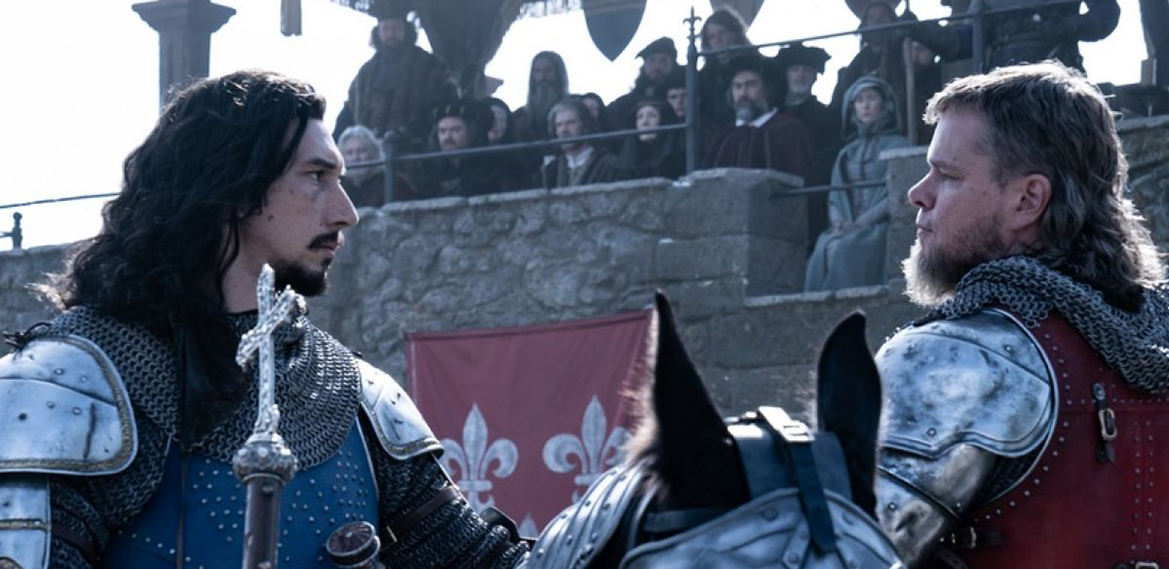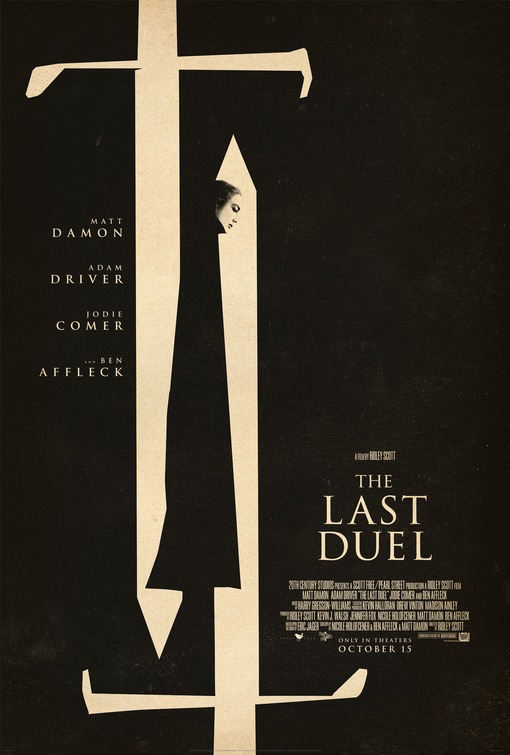“Venom: Let There Be Carnage” is also new to Blu-Ray this week.

The Last Duel
The truth is a fickle thing. What did and did not happen can vary—sometimes subtly and sometimes greatly—depending on the memory and perception of the person telling the story. In “The Last Duel,” which is based on actual history, we get three versions of roughly the same events, which are all regarded as the truth according to whoever is telling the tale. We first see the perspective of Sir Jean de Carrouges (Matt Damon), loyal knight in the service of King Charles VI (Alex Lawther) of France. We then see it from the perspective of squire Jacques Le Gris (Adam Driver), and finally from Marguerite de Carrouges (Judy Comer).
Each of these perspectives begins with a title screen that gives us a chapter and the words “The truth according to….” It’s interesting to note that the words “The truth” linger for a few seconds on Marguerite’s title screen, subtly advising the audience that her story is the most definitive version. It’s a small moment, but I see what director Ridley Scott is trying to do and I find it cringeworthy and ridiculous. It would have been better to treat the events the way the similarly themed “Rashomon” treated its four stories, with each person recounting their version and leaving it up to the audience to decide. Further, the stories the men tell all involve their history together as friends and allies in combat, which are not part of her story and are important to flesh out the background between them to give us an understanding of where they came from, which gives meaning to where they are when we first see them—preparing to duel each other. I also had a major problem with her “truth” when she claimed to not know the consequences of falsely accusing a man of rape, which are very extreme, in a scene in which she also blamed her husband for not telling her. To think that an educated woman of noble birth who grew up as part of a society would not know its consequences for such a thing stretches credulity.
The interesting thing about the major event in question—the rape—is that it’s one of the few things consistent in both Jacques’ and Marguerite’s points of view. It all happens the same way, regardless of the storyteller, the only real difference being where the camera is placed and who it chooses to focus on. Even the immediate aftermath, in which Jacques tries to gaslight Marguerite into not saying anything to Jean for her own good is the same. So yeah, he did it, even by his own admission—no question. The variation comes after, when he does mental gymnastics to try and justify his actions, which only makes him skeevier. He knows what he did, and while he may fool everyone around him including his friend and benefactor Pierre d’Alençon (Ben Affleck), who is the local Count and cousin to the king, he can’t fool himself.
Being a period piece, the sets and costumes of “The Last Duel” are all based on medieval French design. Some of the costumes are so complicated that they take a small squad of other people to help the person put on. Apparently, they also had really bad mullets and dye jobs in medieval France, judging by the hair on both Damon and Affleck. I really hope that was some Hollywood creative license on both.
The most interesting aspect of “The Last Duel” is the science. They were so certain about their scientific principles that laws were made around them. For example, if a woman is raped, she cannot get pregnant from it unless she experiences pleasure, aka orgasm, aka the “little death.” Nowadays we know such a thing to not be scientifically accurate, but back then it’s what they knew to be true. As Mark Twain so perfectly put it, “It ain’t what you don’t know that gets you into trouble. It’s what you know for sure that just ain’t so.” It’s easy to say this about the science of 650 years ago. The question the movie makes me ponder is: what will the world say of our science today 650 years from now? Food for thought. Rent it.
Venom: Let There Be Carnage
Bad movies are a diverse bunch. Some get bad as the story progresses. Some start off bad but are so entertainingly bad that they are a joy to watch—the “good” bad movies. The there’s the worst of the bunch. The ones that cause me to check out in the very beginning, forcing me to slog through them. Occasionally these movies have a thing or two in them that is at least fun or entertaining, making their viewing less painful. “Venom: Let There Be Carnage” shows no such mercy. I was done with it after three minutes.
It’s the sheer stupidity of the second scene that got me. A juvenile prison transport van is carrying a young woman named Frances, nicknamed Shriek (Olumide Olorunfemi), who is called this because she can omit dangerous shockwaves by screaming. She uses this power to try to overcome the one guard (Sean Delaney) in the van with her. Right off the bat, I couldn’t help but ask why they didn’t either a) put something over her mouth so she couldn’t use her power, b) give the guard ear protection, or c) both. That’s when I realized that in a few seconds I put more thought into writing this movie than the actual writers did.
It’s all down hill from there as we then catch up with Eddie Brock (Tom Hardy), who still has the Venom symbiote with him. Venom’s voice is deep but ridiculous in a goofy way. He says outrageous things and even sings at one point, but as hard as he tries, nothing is funny. Venom’s big point of contention is that he needs a chemical found in brains to survive. This same chemical is also found in chocolate, so Venom eats a lot of that, and somehow Eddie found a source of live chickens for Venom to feed on. Why doesn’t Eddie find a butcher shop and buy cow, pig or sheep brains for Venom? One reason I can think of is that doing so would solve the problem and eliminate 90% of their B-grade Lemmon/Matthau banter. The other reason is that once again, I’ve given this more thought than the writers did.
The only somewhat redeeming element in “Venom: Let There Be Carnage” is Woody Harrelson as Cletus Kasady/Carnage. Given the age of Cletus in the opening scene, the character is in his early to mid-forties. I have to hand it to Harrelson, who is 60, he does look good enough to believably play the part. Carnage is a menacing villain, but never really gets to shine with his violence and destruction because the movie is very choppily edited down to a PG-13. At several points, it feels like story beats are missing and the movie, including credits, clocks in at just over an hour and a half. I sometimes hold out hope that an R or Unrated version of a bad movie might be better, but a little more blood and story can’t stop “Venom: Let There Be Carnage” from being an off-kilter disaster. Skip it.
“The Card Counter,” about a professional gambler going from casino to casino on his way to the World Series of Poker, starring Óscar Isaac, Tye Sheridan, Willem Dafoe, and Tiffany Haddish; “South of Heaven,” about a man who is newly released from prison and vows to give his childhood love, now dying from cancer, the best last year of her life–except it’s not that simple, starring Jason Sudeikis, Evangeline Lilly, Shea Whigham, and Michael Paré; and “Dangerous,” about a reformed sociopath who journeys to a remote island to investigate the mystery behind his brother’s demise but soon ends up facing off with more than he bargained for, starring Scott Eastwood, Kevin Durand, Famke Janssen, Tyrese Gibson, and Mel Gibson.
Andrew Hudak is a lifelong film lover and author of the novel “Takedown,” which is available on Amazon, iTunes, and more. His column on Blu-Ray new releases appears every Tuesday. He lives in Connecticut.



